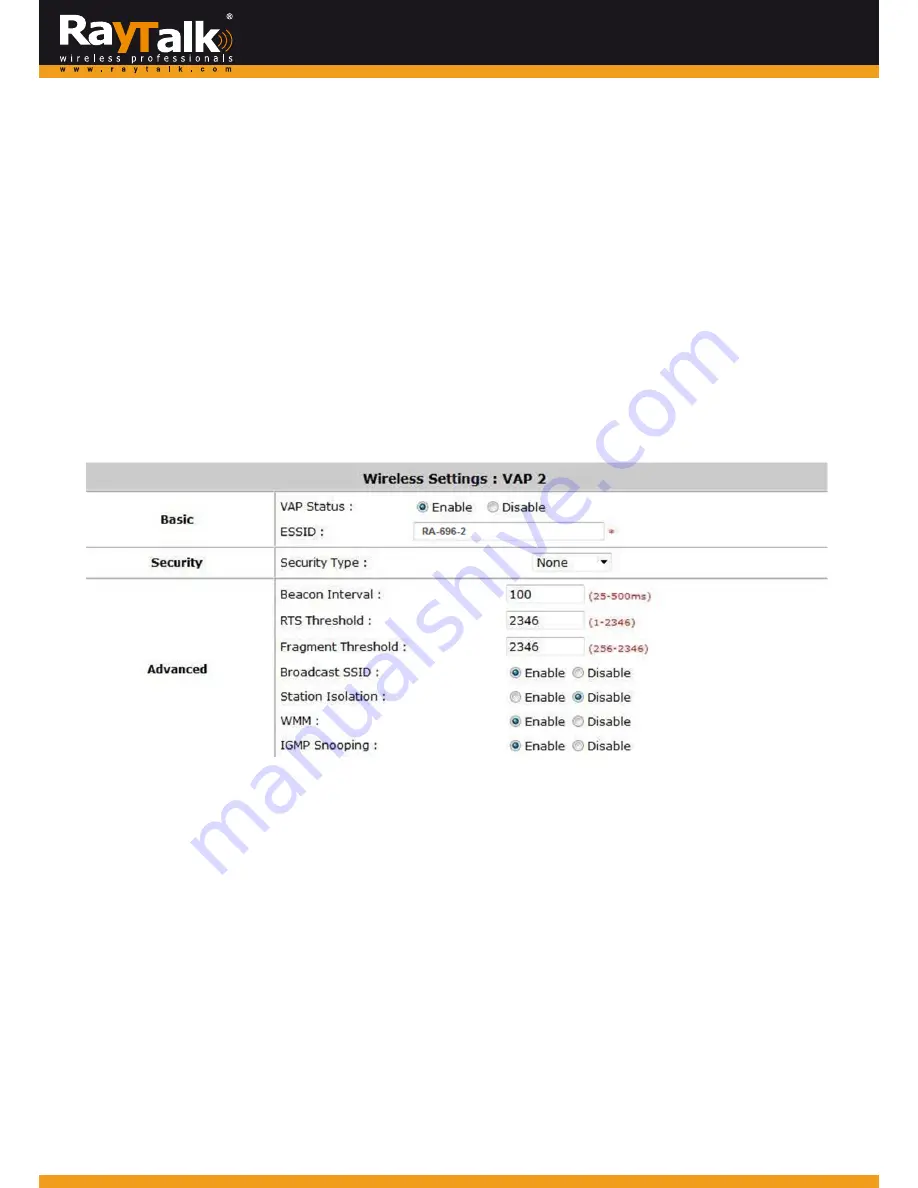
Broadcast
SSID:
The
administrator
has
the
option
of
enabling
or
disabling
the
SSID
for
VAP1
which
is
the
Private
Zone.
Default
value
is
set
at
Disable
where
users
will
not
be
able
to
scan
for
the
SSID.
Station
Isolation:
By
enabling
this
function,
all
stations
wirelessly
associated
to
this
zone
are
isolated
from
one
another
and
can
only
communicate
with
the
system.
WMM:
The
default
is
Enable.
Wi
‐
Fi
Multimedia
(WMM)
is
a
Quality
of
Service
(QoS)
feature
that
prioritizes
wireless
data
packets
based
on
four
access
categories:
voice,
video,
best
effort,
and
background.
Applications
without
WMM
and
applications
that
do
not
require
QoS
are
assigned
to
the
best
‐
effort
category,
which
receives
a
lower
priority
than
that
of
voice
and
video.
Therefore,
WMM
decides
which
data
streams
are
more
important
and
assigns
them
a
higher
traffic
priority.
This
option
works
with
WMM
‐
capable
clients
only.
IGMP
Snooping:
IGMP
is
a
multicast
constraining
mechanism
which
may
flood
the
broadcast
domain.
This
is
effective
for
dense
internet
usage
such
as
conventions
or
campuses.
Normally,
we
use
VAP2,
the
VAP
under
Public
Zone,
to
provide
wireless
service
to
public
clients
in
a
hotspot
environment.
To
configure
Public
Zone’s
Wireless
Settings,
go
to:
System
>>
Service
Zones
,
click
Configure
for
Public
zone.
Wireless
Settings:
VAP2
(Wireless
Settings
for
Public
Zone)
Basic:
Enable
the
VAP
Status
if
you
wish
to
provide
wireless
service
under
this
zone.
Assign
an
ESSID
for
VAP2
under
Public
Zone
or
use
default,
the
ESSID
of
Public
Zone
will
be
broadcasted
in
default
settings
to
allow
it
to
be
scanned
in
the
air.
Security:
Configure
the
wireless
network
under
Public
Zone
with
security
encryption
to
prevent
unauthorized
wireless
association
if
necessary.
The
encryption
standards
supported
are
WEP
and
WPA
‐
PSK.
Advanced:
The
parameters
in
Advanced
are
wireless
settings
that
allow
customization
of
data
transmission,
enhanced
security
and
wireless
roaming.
Beacon
Interval:
The
entered
amount
of
time
indicates
how
often
the
beacon
signal
will
be
sent
from
the
VAP.
The
default
value
is
set
at
100
ms.
RTS
Threshold:
Enter
a
value
between
1
and
2346.
RTS
(Request
to
Send)
Threshold
determines
the
packet
size
at
which
the
system
issues
a
request
to
send
(RTS)
before
sending
the
frame
to
prevent
the
hidden
node
problem.
The
RTS
mechanism
will
be
activated
if
the
data
size
exceeds
the
value
provided.
A
lower
RTS
Threshold
setting
can
be
useful
in
areas
where
many
client
devices
are
associating
with
the
RAYTALK
RA
‐
696
or
in
areas
where
the
clients
are
far
apart
and
can
detect
only
the
RAYTALK
RA
‐
696
but
not
each
other.
The
default
value
is
set
at
2346.
21
















































